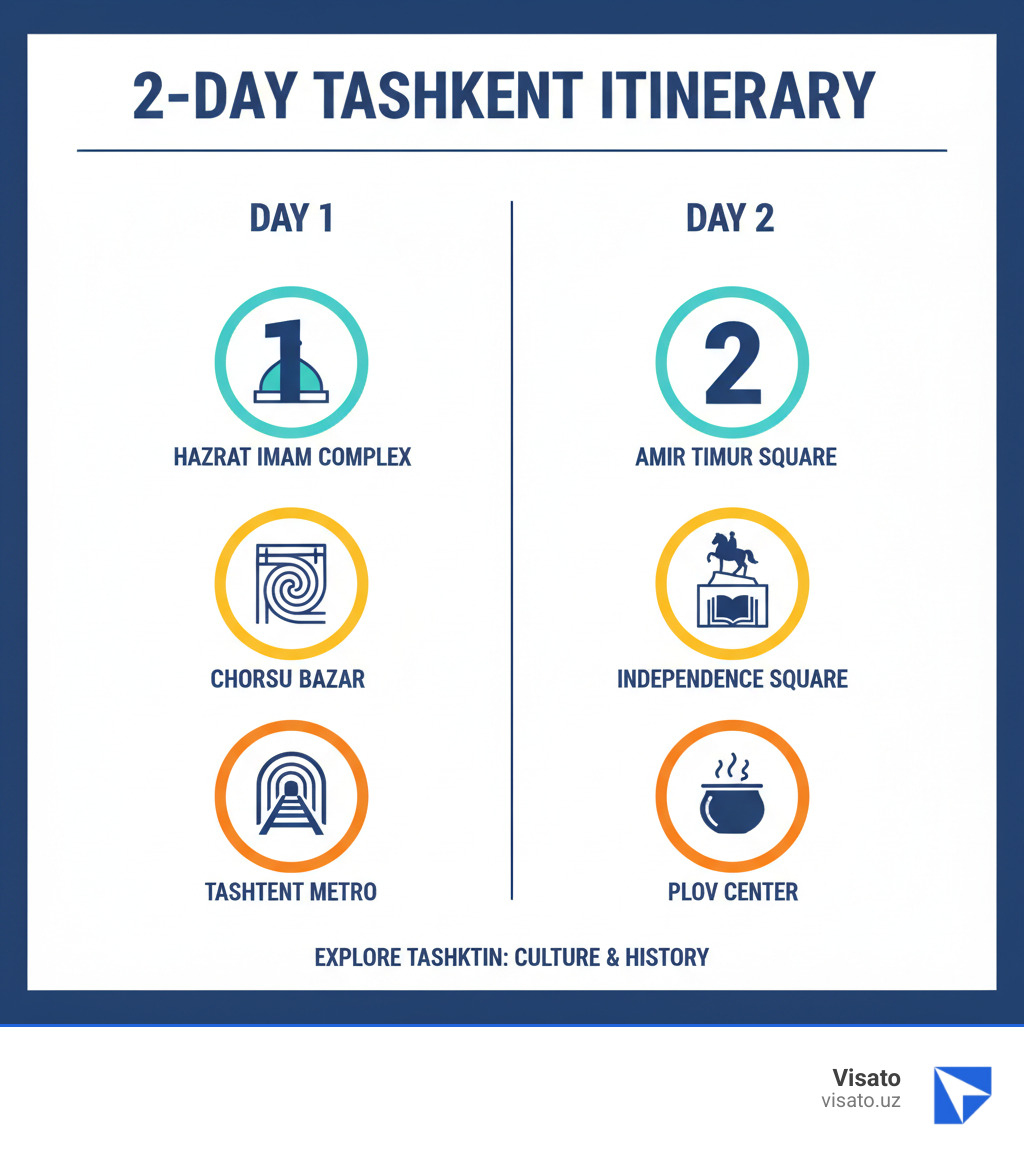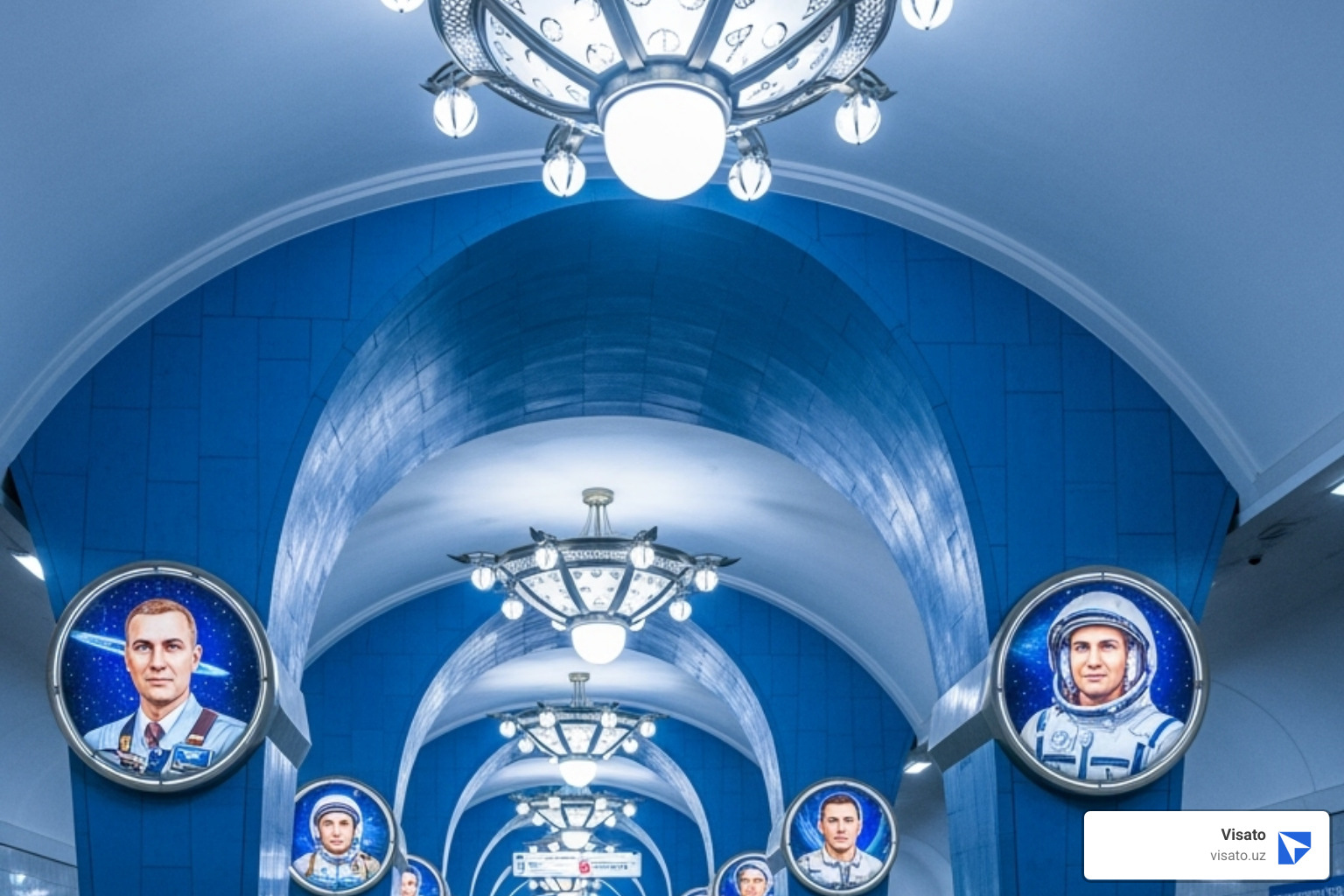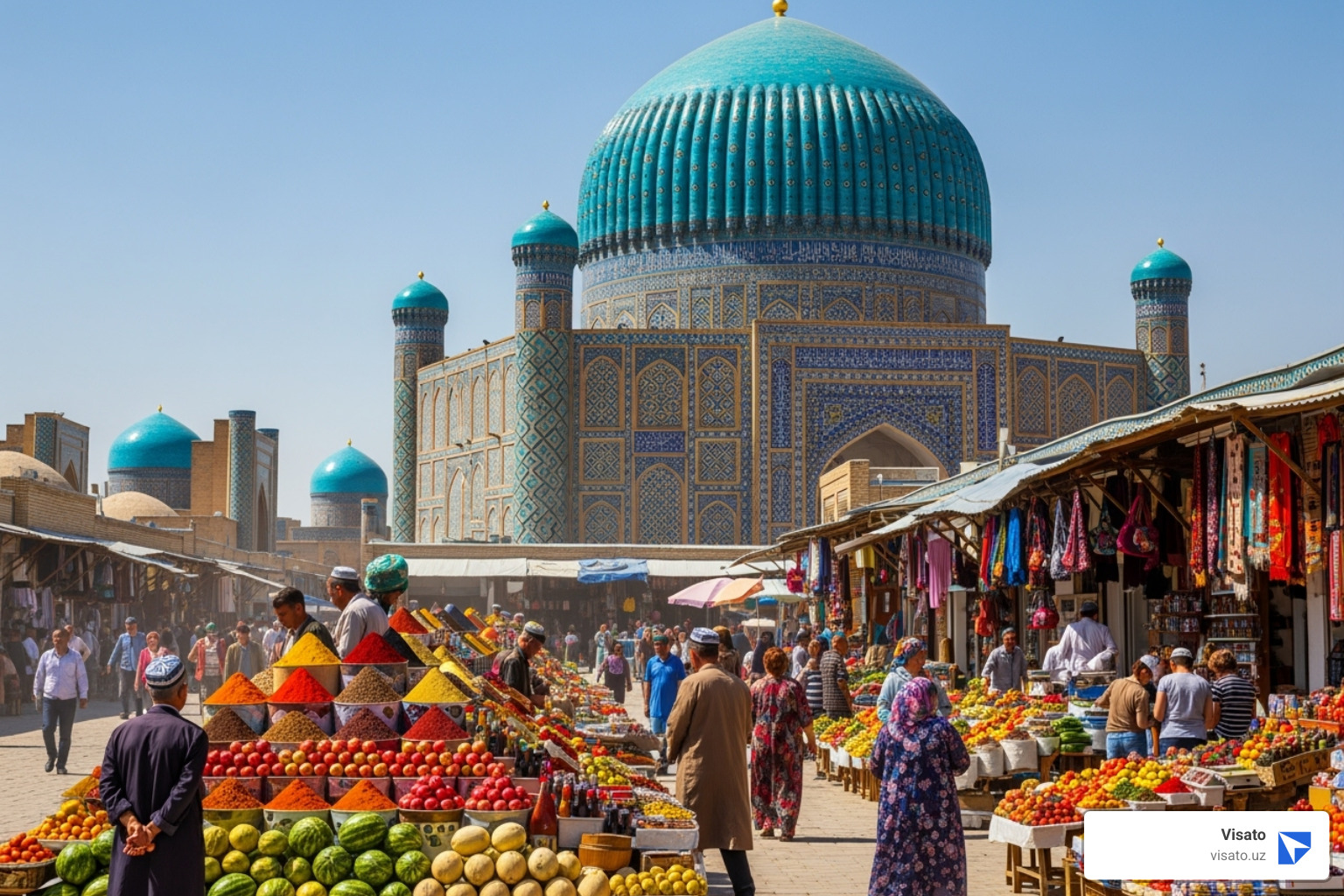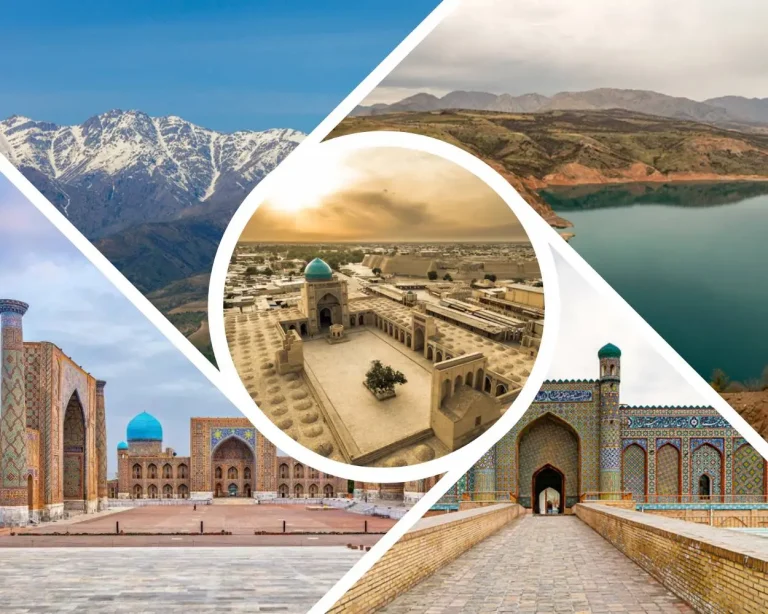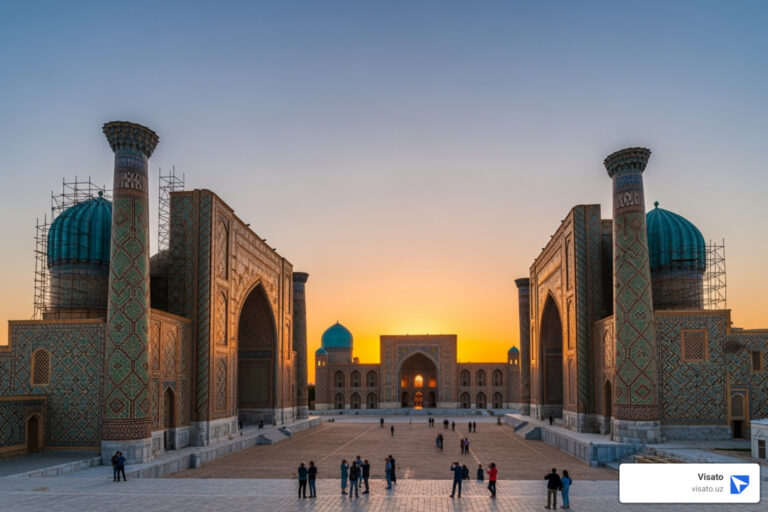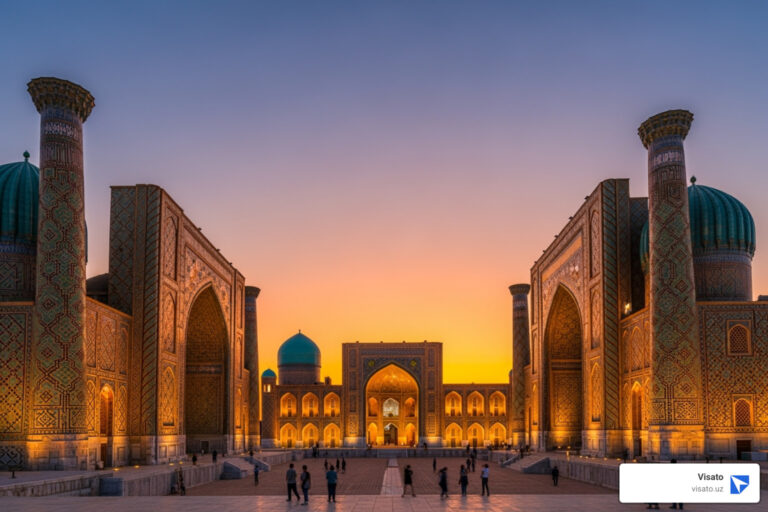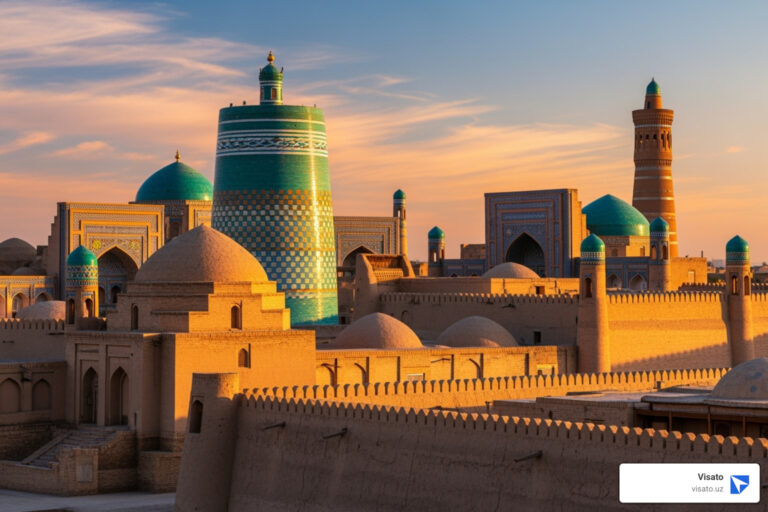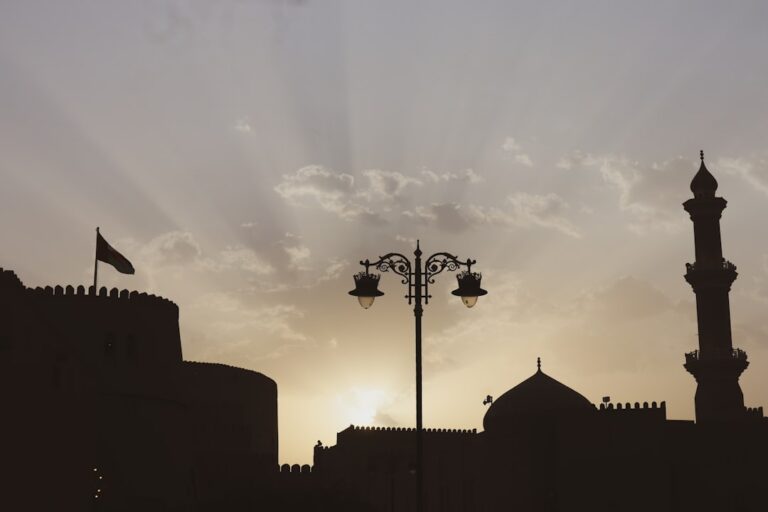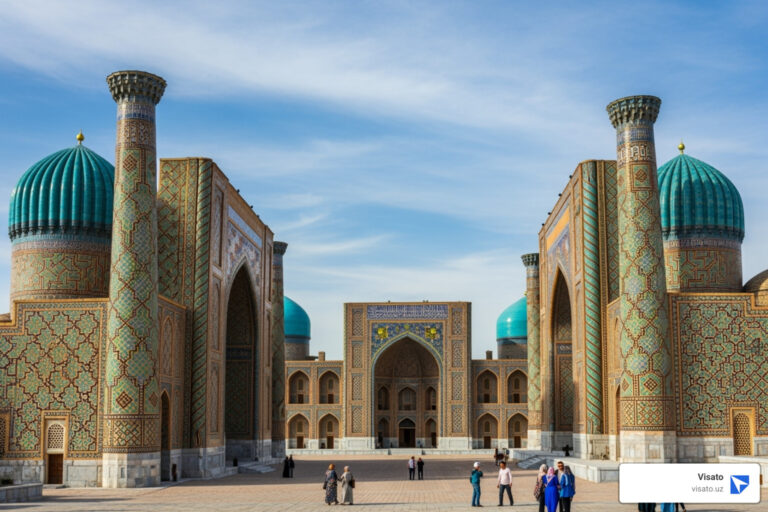Why Tashkent is a Must-Visit City in Uzbekistan
Many travelers might see Tashkent as just a transit point. But the capital of Uzbekistan is far more. If you’re looking for the best places to visit in tashkent uzbekistan, you’ll find a city rich in history and vibrant culture.
Here are some top places you shouldn’t miss:
- Hazrat Imam Complex: See ancient manuscripts and the world’s oldest Quran.
- Chorsu Bazaar: Experience a busy traditional market under a giant blue dome.
- Tashkent Metro: Ride through ornate, Soviet-era subway stations that are true works of art.
- Amir Timur Square: Find the heart of the city with its statue of the national hero.
- Independence Square: Explore Uzbekistan’s main square, a symbol of its freedom.
- Central Asian Plov Center: Taste the national dish, Plov, cooked in giant pots.
Tashkent is the largest city in Central Asia, home to 3 million people. It offers a unique blend of Islamic heritage, Soviet architecture, and modern development. This city is a fantastic starting point for any Uzbekistan adventure, showing a different side of the country.
As Nariman Huseynov from Visato.uz, I’ve helped thousands of travelers explore destinations like Uzbekistan. My team and I have over 5 years of experience in making global travel easier, and we’re experts on the best places to visit in tashkent uzbekistan.
Must-See Historical & Religious Sites
When people think of Uzbekistan’s historic sites, they usually picture Samarkand or Bukhara. But Tashkent has its own stories to tell, and they’re just as fascinating. The Old City area is where you’ll find the spiritual heart of Tashkent, where Islamic architecture meets centuries of Silk Road history. These are some of the most meaningful places to visit in tashkent uzbekistan, and they offer a window into the soul of the city.
Must-see historical places to visit in tashkent uzbekistan
The Hazrat Imam Complex (also called Khast-Imam) is where your historical journey should begin. This isn’t just one building—it’s an entire complex of religious monuments that have witnessed centuries of prayer, learning, and devotion. Walking through its peaceful courtyards feels like stepping back in time.
Inside the complex, you’ll find the Barak Khan Madrasah, a 16th-century Islamic school whose intricate tilework still impresss visitors today. The Tilla Sheikh Mosque stands as the oldest and largest mosque in Tashkent. It was rebuilt after the devastating 1966 earthquake that reshaped much of the city, and its serene atmosphere invites quiet reflection.
But the real treasure here is in the Muyi Mubarak Library. This is where they keep the Uthman Quran, believed to be the oldest Quran in the world. Seeing this ancient manuscript in person is genuinely moving, regardless of your faith. The pages, stained with the blood of Caliph Uthman ibn Affan who was reading it when he was assassinated, connect us to the earliest days of Islam.
The complex also houses the Mausoleum of Abu Bakr Kaffal Shashi, a 10th-century tomb honoring a respected Islamic scholar and poet. There’s a local belief that women hoping to conceive should smear dust from the tomb on their face—a tradition that speaks to the deep faith still alive in Tashkent today.
The Hazrat Imam Complex is about a 10-minute walk from Gafur Gulom Metro Station, and the walk itself is lovely, giving you a taste of the old town. You can find it here: Hazrat Imam Complex on map.
Kukeldash Madrasah & Juma Mosque
Near the colorful chaos of Chorsu Bazaar, you’ll find the Kukeldash Madrasah, the largest madrasah in Tashkent. Built in the 16th century, this impressive building has lived many lives. It’s been a caravanserai where Silk Road travelers rested their weary bones, a fortress during troubled times, and even a museum of atheism during the Soviet era (yes, really—the Soviets had a complicated relationship with religion).
Today, it’s returned to its original purpose as a functioning Islamic school. Students still study here, continuing a tradition of learning that spans nearly 500 years.
Right next door is the Juma Mosque, one of the oldest Friday mosques in the city. Parts of it date back to the 9th century, making it one of the most ancient structures still standing in Tashkent. Together, these two sites tell a story of resilience—they’ve survived earthquakes, political upheaval, and the passage of time. A quick visit here is absolutely worth your time. Find them here: Kukeldash Madrasah on map.
Minor Mosque
For something completely different, head to the Minor Mosque. Built in 2014, it’s proof that Tashkent’s architectural story is still being written. Locals call it the “Snow Mosque” because it’s built entirely from gleaming white marble.
The mosque sits beautifully along the Ankhor Canal, and when the sunlight hits it just right, the whole building seems to glow. It’s particularly stunning in the late afternoon. The intricate portal patterns blend traditional Islamic design with modern sensibilities, creating something that feels both timeless and fresh.
This is one of the most photogenic places to visit in tashkent uzbekistan, so bring your camera. You can find it here: Minor Mosque on map.
A Journey Through Time: Soviet Relics & Modern Landmarks
Tashkent is a city that truly rose from the ashes. After a powerful earthquake rocked the city in 1966, it was rebuilt with a vision, drawing on the best minds and hands from across the Soviet Union. This unique history shaped the cityscape we see today: broad avenues, striking brutalist buildings, grand open squares, and peaceful green spaces. It’s a fascinating blend of Soviet-Modernism and a touch of oriental flair, making these architectural wonders some of the most compelling places to visit in tashkent uzbekistan.
The Tashkent Metro: An Underground Art Gallery
One of Tashkent’s crown jewels, and a must-see for any visitor, is its metro system. It wasn’t just the first in Central Asia; it’s practically an underground art gallery! Forget drab stations – these are “palaces for the people,” following the grand traditions of Moscow and St. Petersburg. Each of its four lines and many stations tells a unique story, adorned with stunning mosaics, polished marble, gleaming granite, intricate carved alabaster, and dazzling chandeliers. It’s a true showcase of Uzbek art and culture.
For years, snapping photos here was a no-go, mainly because the metro doubles as a bomb shelter. But good news! That restriction has been lifted, so now you can capture all the beauty. A ride is incredibly affordable, costing around 1700-2000 Uzbek soms (that’s about $0.15-$0.20!). Trains arrive every 3-5 minutes, offering an efficient and breathtaking way to travel.
While every station is a masterpiece, a few truly stand out. Don’t miss Kosmonavtlar, dedicated to space exploration with its captivating starry ceilings and portraits of cosmonauts. Alisher Navoi station, named after the famous Uzbek poet, will mesmerize you with its blue and white mosaics depicting scenes from his works. Then there’s Mustakillik Maydoni, grand and neat, reflecting the Independence Square above it. And finally, Chorsu, conveniently located near the famous bazaar, often features traditional Uzbek patterns in its design. You could easily spend hours just marveling at these subterranean wonders!
Independence Square (Mustakillik Maydoni)
Stepping out of the metro, you’ll find yourself in Independence Square, also known as Memorial Square. This vast, symbolic space is the beating heart of modern Uzbekistan. It once bore the name Lenin Square during Soviet times, but after gaining independence in 1991, it was proudly renamed to reflect the nation’s newfound freedom.
The square is home to several powerful monuments. You’ll see the impressive Monument of Independence and Virtue, featuring a large globe that highlights Uzbekistan’s current borders, a clear symbol of its sovereignty. Nearby stands the poignant Crying Mother Monument, a solemn tribute to Uzbek soldiers who lost their lives in World War II, accompanied by an Eternal Flame. Surrounded by important government buildings, including the Senate, and beautifully manicured green spaces, Independence Square is a beloved gathering spot for locals and a profound symbol of national pride. You can find it here: Independence Square on map.
Modern architectural places to visit in tashkent uzbekistan
Tashkent’s modern spirit shines brightly through its grand squares and towering landmarks.
Amir Timur Square offers a delightful escape, perfect for a leisurely afternoon stroll. At its heart stands the magnificent 7-meter-high bronze statue of Amir Timur (Tamerlane) on horseback. This revered national hero founded the Timurid Empire, and his statue here, after many name changes for the square, truly signifies his enduring importance to the Uzbek people.
Overlooking this square is the iconic Hotel Uzbekistan. This imposing building is one of Tashkent’s most recognizable sights, especially if you have an appreciation for Soviet-era architecture. During the Soviet Union, grand state hotels were a staple in major cities, and this was the largest and most impressive example in the Uzbek capital. Its sheer size and grandeur are unmistakable! While the interior may not be as dazzling as its exterior, it’s still a piece of living history. Hot tip: Head up to the bar on the 17th floor for a drink and soak in breathtaking panoramic views over the city and Amir Timur Square, especially magical at sunset! You can even make it your home away from home: Hotel Uzbekistan.
Another soaring emblem of modern Tashkent is the Tashkent TV Tower. At an impressive 375 meters, it proudly stands as the tallest tower in Central Asia and ranks among the 11 tallest in the world. You can take an elevator up to the 6th floor to an observation deck, where unparalleled views of the sprawling city await. For an extra special experience, there’s a revolving restaurant called “Koinot” on the 7th floor, perfect for enjoying a meal or a drink with a constantly changing vista. While photography can sometimes be restricted inside the tower itself, the views from the observation deck alone make it well worth the visit!
Top places to visit in tashkent uzbekistan for Local Life & Culture
Beyond the grand monuments and historic sites, Tashkent truly comes alive through its everyday rhythms. To experience the authentic soul of this city, we need to wander through its busy markets, taste its incredible cuisine, explore its artistic heritage, and join locals in their favorite gathering spots. These experiences offer some of the most memorable places to visit in tashkent uzbekistan.
Chorsu Bazaar: A Feast for the Senses
If there’s one place that captures the essence of Tashkent’s daily life, it’s Chorsu Bazaar. This magnificent market has been a trading hub since at least the time of Genghis Khan, and stepping inside feels like entering a different world. The centerpiece is an enormous blue dome that towers over the main market hall, creating a cathedral-like space filled with the colors, aromas, and sounds of Central Asia.
Walking through the aisles, we’re surrounded by mountains of spices in every shade imaginable, from deep red paprika to golden turmeric. Vendors pile high their dried fruits and nuts, offering samples with warm smiles. The bread section alone is worth the visit – watching bakers pull fresh “non” bread from traditional tandoor ovens is mesmerizing, and the smell is irresistible.
This isn’t a tourist attraction that’s been sanitized for visitors. It’s where Tashkent residents do their daily shopping, haggle over prices, catch up with neighbors, and grab a quick lunch from the food stalls. We can sample cheap and delicious samsas (those wonderful savory pastries), observe the meat section where sheep fat and horse meat are sold alongside more familiar cuts, and browse through ceramics and traditional crafts.
The bazaar sits right next to the Kukeldash Madrasah we mentioned earlier, making it easy to combine both visits. Come with an empty stomach and a sense of adventure. You’ll find it here: Chorsu Bazaar on map.
The Culinary Scene: Plov and Beyond
Let’s talk about Plov, because you simply cannot leave Tashkent without trying this dish. It’s not just food – it’s a cultural institution, a ceremony, and for many Uzbeks, a sacred tradition. This hearty rice dish combines tender lamb, carrots, sultanas, and a blend of spices cooked together in lamb fat, creating layers of flavor that are utterly addictive.
Traditionally, Plov is prepared by men in enormous kazan pots, sometimes large enough to feed hundreds of people. There’s even a local belief that drinking a bit of the oil from the bottom of the pot increases male virility – though we’ll leave that claim for you to investigate personally!
The Central Asian Plov Centre is legendary among both locals and visitors. Here, we can watch the theatrical process of Plov being prepared in massive pots and choose from several varieties. But here’s the insider tip: arrive before noon. Once the pots are empty, they’re done for the day, and you’ll have missed out. The atmosphere is lively, the portions are generous, and the experience is unforgettable. Check it out here: Central Asian Plov Centre.
Of course, Uzbek cuisine extends far beyond Plov. We should also try Lagman, those satisfying hand-pulled noodles served with meat and vegetables in a rich broth. Manti are delicious steamed dumplings that arrive at your table in bamboo steamers, often filled with meat or pumpkin. Shashlik – grilled meat skewers seasoned to perfection – makes for a perfect street food snack. And Samsa, those flaky baked pastries filled with meat and onions, are ideal for eating on the go.
For a comfortable sit-down meal, National Food offers an excellent introduction to Uzbek cuisine, with traditional decor and a warm atmosphere near Gafur Gulom Metro Station. Caravan is perfect if we’re watching our budget but don’t want to compromise on authenticity – plus, they often have live music. For a more modern take on traditional dishes, Afsona provides a lovely terrace setting and includes vegetarian options, which can be a relief after days of meat-heavy meals.
Tashkent’s Top Museums
When we’re ready to escape the midday heat or simply want to dig deeper into Uzbekistan’s fascinating history, Tashkent’s museums offer wonderful respites. These cultural institutions rank among the most enriching places to visit in tashkent uzbekistan.
The State Museum of History of Uzbekistan has been collecting artifacts since 1876, and its collection of around 200,000 works spans an incredible 2,500 years. The building itself tells a story – it’s a fascinating example of Soviet-Modernism architecture that attempts to blend Soviet design principles with oriental decorative patterns. We can easily spend a couple of hours here, tracing Uzbekistan’s journey from ancient times through the Silk Road era to the present day.
For those who appreciate craftsmanship and traditional arts, the Museum of Applied Arts is a treasure. Housed in a stunning 1930s building that once belonged to a Russian diplomat, the museum showcases exquisite ceramics, intricate jewelry, traditional clothing, textiles, and embroidery. The building’s interiors are works of art themselves, featuring ghanch (carved and painted plaster) and carved wood that frame the exhibits beautifully.
The State Fine Arts Museum takes us on an artistic journey covering 1,500 years, from 7th-century Buddhist relics to contemporary Uzbek art. It’s a comprehensive overview that helps us understand how artistic traditions evolved in this crossroads of civilizations.
Broadway Alley (Sailkogh Street): Entertainment & Nightlife
As the sun begins to set, Tashkent’s social life shifts to Sailkogh Street, affectionately known as “Broadway Boulevard” by locals. This pedestrian avenue connects Amir Timur Square with Independence Square, making it both a practical walking route and a destination in its own right.
In the early evening, the street fills with families, couples, and groups of friends enjoying the cooler temperatures. Street vendors set up stalls selling everything from quick snacks to handmade souvenirs. Local artists display their paintings and crafts, while performers entertain passersby. We might spot families playing ping-pong at outdoor tables or children chasing each other around the fountains.
The atmosphere is relaxed and welcoming. It’s where Tashkent shows its modern, social side – a place where traditions of communal gathering meet contemporary urban life. Grab some street food, browse the art vendors, or simply find a bench and watch the world go by. It’s one of those places where we don’t need a specific plan; just being there and soaking in the atmosphere is enough. Find this lively pedestrian street here: Sailkogh Street on map.
Planning Your Tashkent Adventure: Practical Tips & Day Trips
After exploring all the wonderful places to visit in tashkent uzbekistan, let’s talk about the practical side of planning your adventure. Having the right accommodation, understanding how to get around, and knowing when to visit can make all the difference in your experience.
When it comes to where to stay, Tashkent offers options for every budget. For budget travelers, The Top Hostel provides clean, comfortable dorms and private rooms with a friendly atmosphere, perfect for meeting fellow travelers. If you’re looking for something in the mid-range, Mirzo Toshkent offers excellent value with modern rooms and great service in a convenient location. For those seeking luxury, the Hyatt Regency Tashkent delivers five-star comfort with top-notch amenities, spa facilities, and impeccable hospitality.
Getting around Tashkent is remarkably easy and affordable. The Tashkent Metro is not just an attraction but also the most efficient way to reach most major sites. For destinations not covered by the metro, we recommend using Yandex Taxi, which works just like Uber and offers fixed prices, eliminating any haggling or confusion. Taxis in Tashkent are incredibly cheap by international standards, making them a convenient option for late-night returns or when you’re tired from sightseeing.
Timing your visit can really improve your experience. The best time to visit Tashkent is during spring (April to May) or autumn (September to October), when the weather is pleasantly mild and perfect for walking around the city. Summer can be scorching hot, with temperatures often exceeding 40°C (104°F), while winter brings cold temperatures and occasional snow.
Tashkent is generally very safe for tourists, with dedicated tourist police patrolling major attractions and helping visitors. The local currency is the Uzbek Som (UZS), and ATMs are widely available throughout the city, especially near hotels and shopping areas. Most restaurants and hotels also accept credit cards, though it’s always wise to carry some cash for markets and smaller vendors.
We always recommend securing proper travel insurance before any international trip. Get a 5% discount with Heymondo, which offers comprehensive coverage custom for travelers, giving you peace of mind while exploring Uzbekistan.
Day Trips & Nature Escapes
While Tashkent itself offers plenty to see, the surrounding region provides fantastic opportunities for nature lovers and adventure seekers. The Chimgan Mountains, located about 80 kilometers northeast of the city, offer a refreshing escape from urban life. These mountains are particularly popular during winter for skiing, but they’re equally beautiful in summer for hiking and picnicking.
Adjacent to the mountains is Charvak Lake, a stunning turquoise reservoir surrounded by dramatic peaks. The lake is perfect for swimming, boating, and simply relaxing by the water while enjoying the mountain views. The area is part of the Ugam-Chatkal National Park, which offers numerous hiking trails through pristine nature, where you might spot rare wildlife and enjoy breathtaking alpine scenery.
Most visitors opt for organized day tours to these destinations, as public transportation can be limited. We recommend booking tours and activities in advance to ensure availability and get the best experience with knowledgeable guides who can show you hidden gems and handle all the logistics.
Practical Tips for Visitors
Before you start exploring all the amazing places to visit in tashkent uzbekistan, here are a few final practical tips to keep in mind. The city is well-connected, and most attractions are either within walking distance of metro stations or a short taxi ride away. Don’t hesitate to ask locals for directions – Uzbeks are famously hospitable and often eager to help tourists, even if there’s a language barrier.
Uzbekistan is a predominantly Muslim country, so dressing modestly when visiting religious sites shows respect for local customs. This means covering shoulders and knees, and women might want to carry a scarf for entering mosques.
Most importantly, take your time to soak in the atmosphere. Tashkent moves at a different pace than many Western cities, and some of the best experiences come from simply sitting in a chaikhana (teahouse), sipping green tea, and watching daily life unfold around you.

